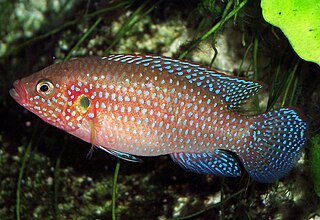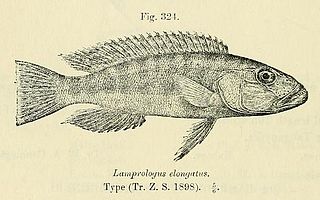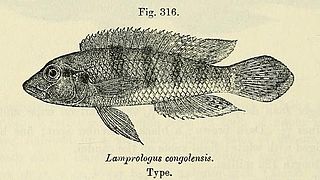
Hemichromis is a genus of fishes from the cichlid family, known in the aquarium trade as jewel cichlids. Jewel cichlids are native to Africa. Within West Africa, Hemichromis species are found in creeks, streams, rivers and lakes with a variety of water qualities including brackish water lagoons.

Sarotherodon is a genus of oreochromine cichlids that are native to the northern half of Africa, with a single species, S. galilaeus, also ranging into the Levant. A couple of species from this genus have been introduced far outside their native range, and are important in aquaculture. Most other species have small ranges and some are seriously threatened. They mainly inhabit fresh and brackish water, but a few can live in salt water. Species in this genus, as well as those in several other oreochromine and tilapiine genera, share the common name "tilapia" and historically they were included in the genus Tilapia.
Teleogramma is an African genus of cichlids with five species. These dark and slender fish barely reach 10 cm (4 in) in length and are limited to rapids in the Western Congo River basin in DR Congo/Congo Brazzaville. They are distinctive, with specialized anatomy. They are characterized by elongated heads with tubular nostrils and a lateral line that is not interrupted, as it is in most cichlids.

Nanochromis is a genus of small cichlids endemic to the Congo River Basin in Central Africa.

Steatocranus is a genus of small rheophilic cichlids mostly native to the Congo River Basin in DR Congo/Congo Brazzaville, although one species, S. irvinei, is restricted to the Volta River in Ghana and Burkino Faso, and it belongs in a separate genus. There are also at least c. 10 undescribed species in the Congo River basin awaiting scientific description.

Labeo is a genus of carps in the family Cyprinidae. They are found in freshwater habitats in the tropics and subtropics of Africa and Asia.

Lepidiolamprologus is a small genus of cichlids endemic to Lake Tanganyika in eastern Africa. It is closely related to Altolamprologus. and there is the possibility that a revision of the genus could see more species added.

Telmatochromis is a small cichlid genus of the subfamily Pseudocrenilabrinae. These ray-finned fishes are endemic to the Lake Tanganyika basin in Africa.
Mastacembelus is a genus of many species of spiny eel fish from the family Mastacembelidae. They are native to Africa and Asia. Most are found in rivers and associated systems, but there are also species in other freshwater habitats and a particularly rich radiation is found in the Lake Tanganyika basin with 15 species. A few species can even occur in brackish water.

Synodontis is the largest genus of mochokid catfishes. It is the biggest genus within the 10 genera and 190 different species in the family Mochokidae. Synodontis has over 131 different species within the genus. Synodontis are also known as squeakers, due to their ability to make stridulatory sounds through their pectoral fin spines when handled or disturbed. Synodontis make a sound that sounds like squeaking by rubbing their spines together. They do this when they have been frightened or when they become angry. Synodontis may also squeak when they are taken out of the water. These catfish are small- to medium-sized fish with many species exhibiting attractive spotted markings. Some species are also known for naturally swimming belly-up, earning the name upside-down catfish. Some of these species are Synodontis contractus and Synodontis nigriventris. While some of these species are known to swim upside down, another species, Synodontis multipunctatus, is a brood parasitic cuckoo catfish.

Brycinus is a genus of ray-finned fish in the family Alestiidae. Like other "African characids", they were formerly included in the Characidae but are actually somewhat more distantly related Characiformes.

Chrysichthys is a genus of claroteid catfishes native to Africa. Two fossil species are known. Chrysichthys macrotis, Van Neer, 1994, is known from the Miocene-Pliocene of the Albertine Rift in Uganda and Chrysichthys mahengeensis, Murray & Budney, 2003, is known from the Eocene of Mahenge, Tanzania.

Marcusenius is a genus of elephantfishes native to Africa. Its members are highly diverse in size, with the smallest species reaching less than 15 cm (6 in) and the largest more than 1 m (3.3 ft).

Paretroplus is a genus of fishes in the cichlid family, all of which are endemic to lakes and rivers of Madagascar. The vast majority are threatened and restricted to the northwestern part of the island. Only P. polyactis is found in the southern half of Madagascar and only P. polyactis and P. gymnopreopercularis are found in eastern drainages. Most are restricted to freshwater, but at least P. polyactis and P. maromandia can also be seen in brackish habitats.
Clypeobarbus is a genus of small cyprinid fishes native to Africa. Most species are restricted to the Congo River Basin, but C. pleuropholis is also found in the Chad Basin, while C. bellcrossi is from the Zambezi and C. hypsolepis is from rivers in Western Africa.
Lamprologus lethops is a species of cichlid fish from areas with fast current in the Congo River in Central Africa, where it is believed to live in depths as great as 160 m (520 ft) to 200 m (660 ft) below the surface. It reaches about 10 cm (4 in) in length with males growing somewhat larger than females, is all whitish in color (non-pigmented), and essentially blind as adult, as their eyes are covered in a thick layer of skin. The eyes of juveniles are rudimentary and not covered by skin.

Alestopetersius is a genus of characins, fish found mostly in Congo River Basin in Middle Africa with one species from the lower Niger River in Nigeria. There are currently 10 described species in this genus.

Enteromius is a genus of small to medium-sized cyprinid fish native to tropical Africa. Most species were placed in the genus Barbus.
Louise Schilthuis, also known as Lubbina Schilthuis, was a Dutch zoologist and a curator at the Zoology Museum at the University of Utrecht. She was active in the late 19th century and published at least two papers, both describing new species, on the specimens collected in the Congo by M.A. Greshof, a Dutch collector and trader, on the amphibians in 1889 and on the fishes on 1891. Boulenger named the mormyrid Marcusenius schilthuisiae after her.

Lamprologus congoensis, the Congo lionhead cichlid is a species of riverine cichlid which is widespread in the Congo River, it is the type species of the genus Lamprologus.















